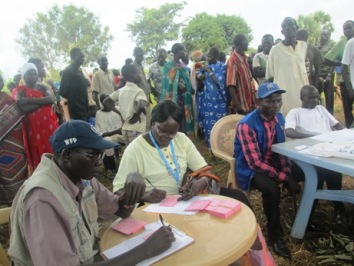UNHCR, S. Sudan launch biometric registration of IDPs
September 20, 2014 (NIMULE) – The United Nations Refugee Agency (UNHCR) and South Sudanese authorities launched on Saturday the biometric registration of the internally displaced persons (IDPs) who fled armed conflict to Nimule, a border town with Uganda.

Registration of the IDPs will take place from 20-23 September and again from 25-26.
During the launch, UNHCR and its partners lauded the state government, local and national authorities for their efforts towards promotion and supporting this initiative, which follows an assessment conducted by aid workers operating in Nimule.
In the past, however, registration of IDPs was undertaken by individual agencies in the past in Nimule area for the purposes of distributing the much-needed humanitarian assistance. The total population of the IDPs reportedly ranged from 3,000 to 30,000.
“This UNHCR registration will be the first comprehensive biometric registration exercise in Nimule, and is intended to provide an accurate and updated number of IDPs, verify newly arrived IDPs, eliminate double registrations of the same individuals, as well as to better understand continuing movements,” UNHCR said in a statement.
“It will also help identify Persons with Specific Needs (PSNs),including unaccompanied minors, separated children, child-headed households and single women with family support so that authorities and humanitarian personnel can better provide appropriate services,” it added.
Meanwhile, the IDPs were requested to bring all household members as well as all documents relating to themselves and their family members, such as identity cards, school certificates, birth certificates, ration cards and any other documents to enable authorities accurately conduct the registration process.
The majority of IDPs, mainly women, children and the elderly reportedly hailed from Jonglei state. Initially, the population gathered mainly in churches, schools and under trees while some were hosted by relatives who arrived in Nimule at the intensity of the conflict.
Since violence broke out in South Sudan late last year, over 1.3 million people have reportedly been displaced mainly from Juba and the states of Jonglei, Unity and Upper Nile.
(ST)
